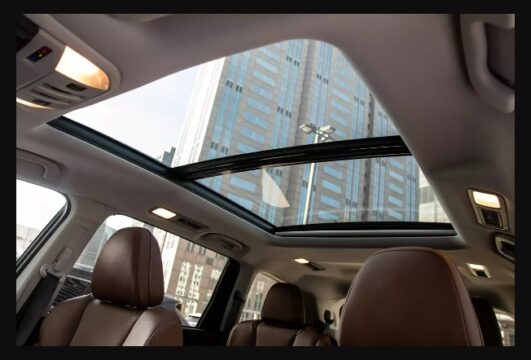Replacing sky slider roofs with glass in vehicles offers enhanced visibility, a sleek design, and a sense of spaciousness. With improved safety features, customization options, ease of maintenance, energy efficiency, and potential for future advancements, glass roofs have the potential to transform the driving experience.
Vehicle design plays a crucial role in capturing our attention and creating a lasting impression. From sleek exteriors to comfortable interiors, every element contributes to a vehicle’s overall aesthetics and functionality.
One notable feature that has recently gained popularity is the sky slider roof, offering a unique open-air experience. However, a proposal to replace the sky slider with glass roofs presents a compelling alternative that combines style, functionality, and safety.
Table of Contents
What are the Advantages of Glass Roofs?

Enhanced visibility and natural light
One of the significant advantages of replacing the sky slider with glass roofs is the increased visibility and natural light it offers.
The transparency of glass allows for an unobstructed view of the surroundings, providing a panoramic experience for the occupants. Natural light flooding into the cabin creates a pleasant ambiance and a stronger connection to the outside environment.
Aesthetically pleasing design
Glass roofs add a touch of elegance and sophistication to vehicle design. A sleek and seamless glass roof complements modern aesthetics, giving vehicles a premium look.
Whether it’s a luxury sedan or a compact SUV, the addition of a glass roof elevates the overall visual appeal, making a bold statement on the road.
Increased sense of spaciousness
The use of glass roofs creates an illusion of spaciousness within the vehicle cabin. The unobstructed view of the sky and surroundings gives occupants a sense of openness, making the interior feel larger and more inviting. This feeling of expansiveness can enhance the overall comfort and enjoyment of the driving experience.
What are the DisAdvantages of Glass Roofs in vehicles?
Glass roofs in vehicles also come with a few disadvantages to consider.
Firstly, heat accumulation can be a concern, as glass has the potential to create a greenhouse effect, leading to increased interior temperatures. This may require additional reliance on air conditioning systems to maintain a comfortable cabin environment.
Secondly, glare can be an issue, especially when sunlight reflects off the glass surface, potentially impairing visibility for the driver and occupants. This glare can be more pronounced in certain weather conditions, posing a safety risk.
Privacy is another consideration, as glass roofs offer limited privacy options compared to solid roofs. Passengers may feel exposed, and there is a potential for increased visibility from the outside.
Cost is another factor to take into account. Glass roofs typically come at a higher initial cost than traditional roofs, and repair or replacement costs can be expensive in case of damage.
The weight of the glass roof can also impact the vehicle’s performance. The additional weight can affect fuel efficiency and handling, potentially reducing overall efficiency and agility.
Lastly, the fragility of glass makes it more susceptible to cracks or chips. Even with advancements in impact-resistant glass, there is still a higher vulnerability to damage than other roof materials.
Considering these disadvantages alongside the benefits is crucial when deciding whether to replace a sky slider with a glass roof in a vehicle.
What are the Safety Considerations?

Impact-resistant glass technology
When it comes to safety, replacing the sky slider with glass roofs might raise concerns. However, advancements in glass technology have resulted in impact-resistant materials that can withstand potential hazards.
Reinforced glass designed specifically for automotive applications provides durability and protection against external forces, ensuring the safety of passengers.
Reinforced structural integrity
Glass roofs can be engineered to maintain the structural integrity of the vehicle. Manufacturers can incorporate additional reinforcement materials, such as laminated glass and supportive frames, to ensure the roof remains sturdy during impacts or accidents. These measures contribute to the overall safety of the vehicle and its occupants.
Protection against UV rays
Concerns about sun exposure and harmful UV rays can be addressed through the use of specialized glass coatings. UV-protective films or tinted glass can be applied to the roof, blocking a significant portion of UV radiation from entering the cabin.
This safeguard protects occupants from potential health risks and prevents interior fading and damage caused by prolonged sun exposure.
Toyota Tacoma Check Engine Light Codes; All You Need To Know
Engine rides
What are Customization and Versatility Considerations?
Tinting options for privacy and glare reduction
Glass roofs can offer customizable tinting options, allowing occupants to adjust the level of privacy and glare reduction according to their preferences.
With the ability to darken the glass, occupants can shield themselves from excessive sunlight or prying eyes when desired, providing a heightened sense of comfort and privacy.
Integration with smart glass technology
The integration of glass roofs with smart glass technology opens up a world of possibilities. By incorporating features like electrochromic glass, occupants can electronically control the opacity of the roof at the touch of a button.
This advanced technology offers a seamless transition from transparent to opaque, ensuring optimal comfort and convenience.
Adjustable opacity for personalized comfort
The ability to adjust the opacity of the glass roof allows for personalized comfort based on varying weather conditions and individual preferences.
Occupants can control the amount of sunlight entering the cabin, reducing glare and maintaining a comfortable interior temperature. This versatility ensures a pleasant driving experience regardless of the external environment.
What are Maintenance and Durability Considerations?
Easy cleaning and maintenance
Maintaining a glass roof is relatively simple and hassle-free. The smooth surface of the glass makes it easy to clean, requiring only a gentle wipe with a suitable glass cleaner.
Unlike fabric-based sky sliders, glass roofs are less prone to accumulating dirt and debris, ensuring a pristine appearance with minimal effort.
Weather resistance and durability
Glass roofs are designed to withstand various weather conditions, including heavy rain, snow, and extreme temperatures.
The glass used in automotive applications undergoes rigorous testing to ensure its durability and resistance to environmental elements. Proper sealing and insulation techniques further enhance weather resistance, ensuring a comfortable and leak-free cabin.
Long-lasting performance
With proper care and maintenance, glass roofs have a long lifespan, providing long-lasting performance and value. The high-quality materials used in their construction ensure durability and resistance to common wear and tear.
Investing in a glass roof can prove to be a wise choice, as it offers a reliable and enduring feature in your vehicle.
What are Energy Efficiency Considerations?
Thermal insulation properties
Glass roofs can contribute to energy efficiency by providing effective thermal insulation. Advanced glass technologies incorporate thermal barriers that minimize heat transfer, helping to regulate the interior temperature.
This insulation reduces the reliance on air conditioning systems, resulting in energy savings and a more sustainable driving experience.
Reduction in air conditioning usage
The increased natural light and improved thermal insulation of glass roofs can reduce the need for excessive air conditioning usage.
The glass acts as a barrier, preventing heat from entering the cabin during hot weather and reducing the strain on cooling systems. This energy-efficient feature benefits the environment and enhances fuel efficiency for vehicles.
Potential for solar energy integration
In the future, glass roofs could be integrated with solar energy-harvesting capabilities. By incorporating photovoltaic technology into the glass panels, sunlight can be converted into electricity to power various vehicle systems. This innovation holds the potential to enhance energy efficiency further and reduce carbon emissions, contributing to a greener and more sustainable transportation future.
Conclusion
In conclusion, the proposal to replace the sky slider with glass roofs in vehicles presents numerous advantages and opportunities. The enhanced visibility, aesthetic appeal, and increased sense of spaciousness make glass roofs an appealing choice for automotive design. With advancements in safety, customization, maintenance, energy efficiency, and the potential for future technological integration, glass roofs have the potential to redefine the driving experience and shape the future of vehicle design.







3 Comments